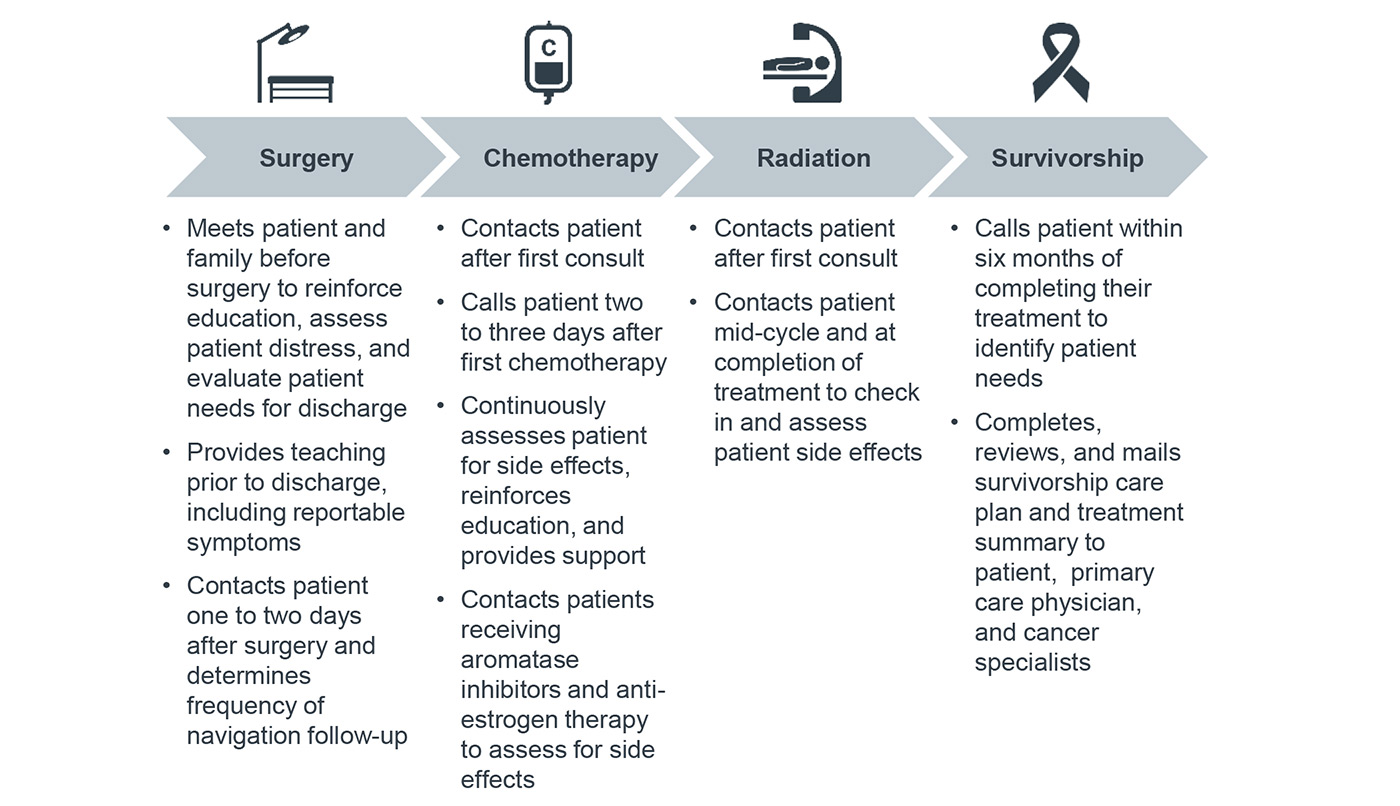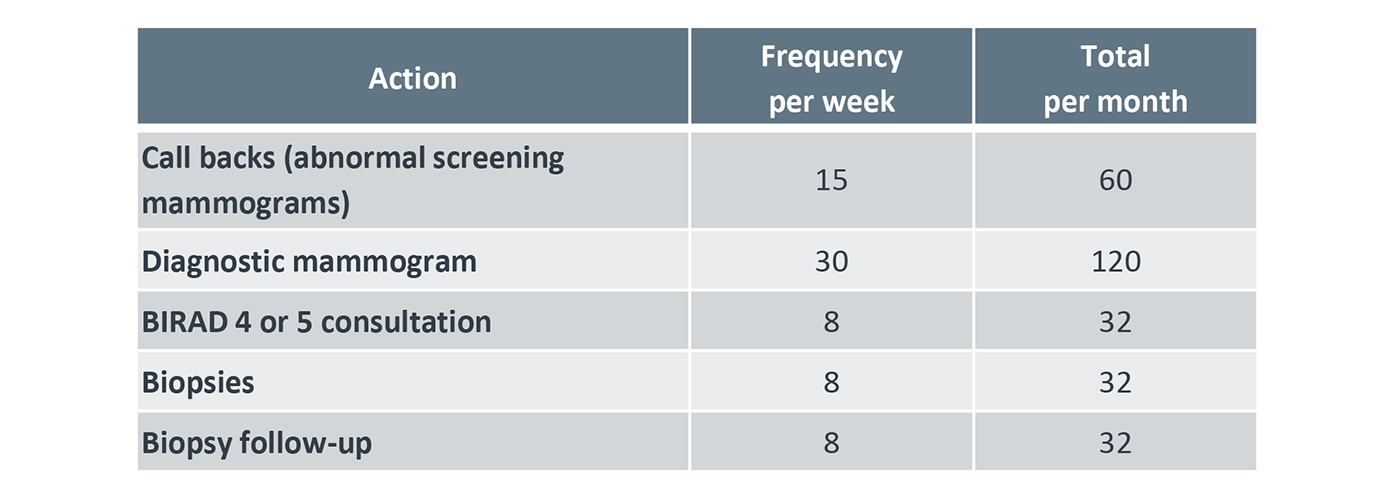Auto logout in seconds.
Continue LogoutBy Deirdre Saulet and Kate Wister
Navigation has become an important element of patient care at most cancer programs across the country. Navigators have the potential to greatly improve the patient experience, drive care quality, and even reduce costs.
However, cancer programs—even those within the same system—often define navigation differently. This lack of standardization can make it difficult to ensure that all patients in your system are receiving the same level of care. OhioHealth recognized the importance of helping standardize navigation back in 1999, when they started an initiative to establish defined patient touchpoints at key intervals during breast cancer care.
OhioHealth develops navigation care standards for breast cancer
The cancer program leaders at OhioHealth recognized that each patient would benefit from connecting with their care team at critical points along the cancer continuum, such as after diagnosis and when starting chemotherapy. They also realized that navigators, who often work with patients across the entirety of their treatment, were uniquely poised to provide this outreach.
Related Resources
6 ways to get the most of out your patient navigation program
They decided to start by developing navigation standards for breast cancer patients. To develop the standards, a multidisciplinary team of physicians, nurses, frontline staff, and breast cancer patients collaborated to map out the breast cancer patient pathway.
The team then identified key touch points along the pathway where patients would benefit from interaction with the care team. These include meeting with patients before surgery for education and distress screening and calling patients at established intervals during treatment to assess side effects.
It took the team two years to develop the breast navigation pathway and implement these standards at the two OhioHealth hospitals at the time: Riverside Methodist Hospital and Grant Medical Center. From 2005 onward these navigation standards were expanded to lung, colorectal, ovarian, and head and neck tumor sites as well.
As OhioHealth grew from a two-hospital system to a ten-hospital system, these navigation standards have been implemented at all ten OhioHealth hospitals, with a goal of navigating all cancer patients at all care sites.
Sample Treatment Breast Health Nurse Navigator Responsibilities

Diagnostic navigators help decrease the time from detection of an abnormality to diagnosis from 25 to 8 days
Importantly, OhioHealth realized that the time leading up to and immediately following diagnosis can be some of the most stressful for patients. To ensure they provide support during this time, OhioHealth hired diagnostic breast health navigators to work with patients who’ve received an abnormal mammogram from detection of the abnormal finding through diagnosis.
These diagnostic navigators receive a daily report via their Epic EMR of all abnormal mammograms. They will then call these patients to walk them through their results and help schedule the patient for additional imaging or biopsies. The diagnostic navigators also coordinate with the patient’s primary care provider and biopsy surgeon to help facilitate communication and appropriate scheduling.
Average Volumes per 1.0 FTE Diagnostic Breast Health Nurse

These navigators support the patient throughout the diagnostic process, assessing patient stress, providing education, and answering patient questions. After implementing the role of the diagnostic breast health navigator, OhioHealth was able to decrease the time from detection of an abnormality to diagnosis from 25 days to less than 8 days.
Ensuring smooth hand offs from diagnosis to treatment
If a patient is diagnosed with cancer, the diagnostic breast health navigator transfers the patient to a treatment breast health navigator. This treatment navigator remains with the patient through survivorship, providing education and support at key points during the patient’s journey, as defined by OhioHealth’s navigation care standards.
Due to the success of the diagnostic breast health nurse navigators, OhioHealth is currently in the process of building out diagnostic navigation touchpoints for colorectal and lung cancer patients as well. This work has also helped OhioHealth prepare for value-based care, and they are currently exploring bundled payments for breast biopsies.
Don't miss out on the latest Advisory Board insights
Create your free account to access 1 resource, including the latest research and webinars.
Want access without creating an account?
You have 1 free members-only resource remaining this month.
1 free members-only resources remaining
1 free members-only resources remaining
You've reached your limit of free insights
Become a member to access all of Advisory Board's resources, events, and experts
Never miss out on the latest innovative health care content tailored to you.
Benefits include:
You've reached your limit of free insights
Become a member to access all of Advisory Board's resources, events, and experts
Never miss out on the latest innovative health care content tailored to you.
Benefits include:
This content is available through your Curated Research partnership with Advisory Board. Click on ‘view this resource’ to read the full piece
Email ask@advisory.com to learn more
Click on ‘Become a Member’ to learn about the benefits of a Full-Access partnership with Advisory Board
Never miss out on the latest innovative health care content tailored to you.
Benefits Include:
This is for members only. Learn more.
Click on ‘Become a Member’ to learn about the benefits of a Full-Access partnership with Advisory Board
Never miss out on the latest innovative health care content tailored to you.
